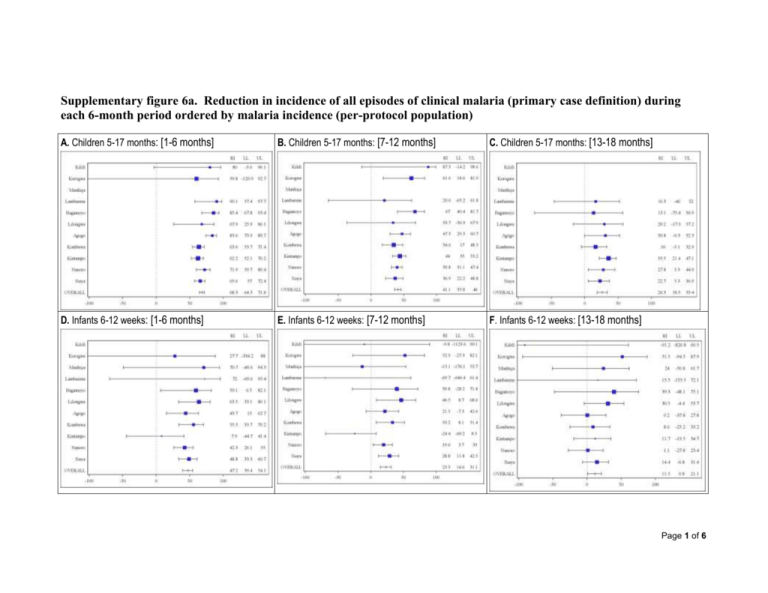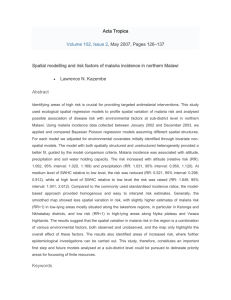Supplementary figure 6a. Reduction in incidence of all
advertisement

Supplementary figure 6a. Reduction in incidence of all episodes of clinical malaria (primary case definition) during each 6-month period ordered by malaria incidence (per-protocol population) A. Children 5-17 months: [1-6 months] B. Children 5-17 months: [7-12 months] C. Children 5-17 months: [13-18 months] D. Infants 6-12 weeks: [1-6 months] E. Infants 6-12 weeks: [7-12 months] F. Infants 6-12 weeks: [13-18 months] Page 1 of 6 Clinical malaria primary case definition: Illness in a child brought to a study facility with a temperature of ≥ 37.5°C and P. falciparum asexual parasitemia at a density of > 5000 parasites per cubic millimeter or a case of malaria meeting the primary case definition of severe malaria. RI: percentage of reduction in incidence of all episodes of clinical malaria (primary case definition) over the 6-month period. LL = lower limit of the 95% confidence interval. UL = Upper limit of the 95% confidence interval. [1-6 months] = 14 days post dose-3 until 6 months post dose-3. [7-12 months] = 6 months post dose-3 until 12 months post dose-3. [13-18 months] = 12 months post dose-3 until 18 months post dose-3. The size of each blue square reflects the relative number of subjects enrolled at each study site. The horizontal bars show the lower limit and upper limit of the 95% confidence interval. Study sites are ordered from lowest (Kilifi) to highest (Siaya) incidence of clinical malaria, defined as a measured or reported fever within previous 24h and parasite density >0 parasites per cubic millimeter (i.e. clinical malaria secondary case definition), measured in control infants 6-12 weeks of age at enrollment during 12 months of follow-up. The incidence of clinical malaria (total number of episodes/person year) and the reduction in incidence was calculated by 6-monthly periods and presented with 95% CIs. These results are expressed as a reduction in incidence and not a vaccine efficacy because the Page 2 of 6 randomization is lost when dividing the analysis by 6-month breakdown. Children who begin the analysis at 6 months or 12 months post dose-3 are not the same group of children than those who were randomized at month zero. Page 3 of 6 Supplementary figure 6b. Reduction in incidence of all episodes of clinical malaria (primary case definition) during each 6-month period ordered by malaria incidence (intention-to-treat population) A. Children 5-17 months: [0-8 months] B. Children 5-17 months: [9-14 months] C. Children 5-17 months: [15-20 months] D. Infants 6-12 weeks: [0-8 months] E. Infants 6-12 weeks: [9-14 months] F. Infants 6-12 weeks: [15-20 months] Page 4 of 6 Clinical malaria primary case definition: Illness in a child brought to a study facility with a temperature of ≥ 37.5°C and P. falciparum asexual parasitemia at a density of > 5000 parasites per cubic millimeter or a case of malaria meeting the primary case definition of severe malaria. RI: percentage of reduction in incidence of all episodes of clinical malaria (primary case definition) over the 6-month period. LL = lower limit of the 95% confidence interval. UL = Upper limit of the 95% confidence interval. [0-8 months] = from dose-1 until 8 months post dose-1. [9-14 months] = 8 months post dose-1 until 14 months post dose-1. [15-20 months] = 14 months post dose-1 until 20 months post dose-1. The size of each blue square reflects the relative number of subjects enrolled at each study site. The horizontal bars show the lower limit and upper limit of the 95% confidence interval. Study sites are ordered from lowest (Kilifi) to highest (Siaya) incidence of clinical malaria, defined as a measured or reported fever within previous 24h and parasite density >0 parasites per cubic millimeter (i.e. clinical malaria secondary case definition), measured in control infants 6-12 weeks of age at enrollment during 12 months of follow-up. The incidence of clinical malaria (total number of episodes/person year) and the reduction in incidence was calculated by 6-monthly periods and presented with 95% CIs. These results are expressed as a reduction in incidence and not a vaccine efficacy because the Page 5 of 6 randomization is lost when dividing the analysis by 6-month breakdown. Children who begin the analysis at 6 months or 12 months post dose-3 are not the same group of children than those who were randomized at month zero. Page 6 of 6






